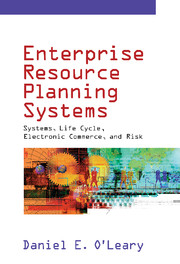15 - ERP Risk: Success and Failure Factors
from PART FOUR - ELECTRONIC COMMERCE AND RISK
Published online by Cambridge University Press: 05 June 2012
Summary
Not all ERP implementations are successful. Implementations succeed and fail for a number of different reasons. Although we have pointed to a number of elements of risk or failure in ERP implementations, the purpose of this chapter is to provide a framework to facilitate risk identification and to identify some additional risks that can lead to ERP success or failure.
A risk is something that can go wrong. Risk is an exposure that can be a success factor if properly handled and a failure factor otherwise. Success factors and failure factors are two sides of the same risk. As in other settings, there is a trade-off between risk and return. Exposing the firm to risk may ultimately provide a greater benefit. For example, as we shall discuss, linking ERP to other applications increases the risk but also increases the potential return from the project.
One model for categorizing risk in the ERP system is given in Figure 15.1. In this matrix, risk is categorized along two dimensions: location in the ERP life cycle and type of application (technical, business, or organizational).
Types of Risk
Risks occur throughout the ERP system life cycle, which ranges from the go-no-go decision on ERP until after the system has gone live, including training issues. The types of risks and the extent of their impact on the organization vary as we move through the life cycle.
Information
- Type
- Chapter
- Information
- Enterprise Resource Planning SystemsSystems, Life Cycle, Electronic Commerce, and Risk, pp. 213 - 224Publisher: Cambridge University PressPrint publication year: 2000
